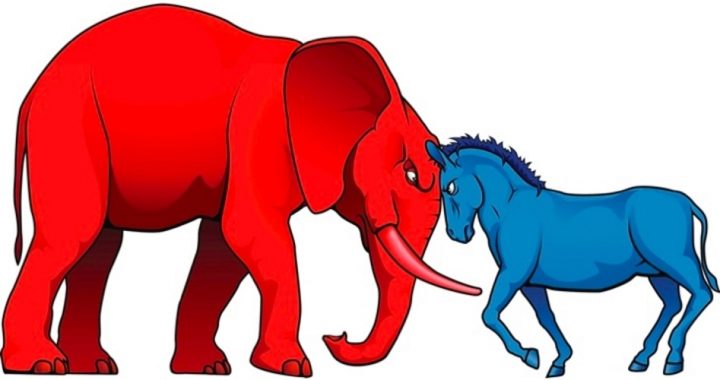
Observers of the political scene have long relied on Nate Silver’s remarkable ability to call the political shots. His Senate forecast, updated Sunday, October 12, found that the Republicans have a 57.9 percent chance of winning a majority in November, while Democrats have just a 42.1 percent chance of keeping the majority they currently enjoy.
Silver says that it’s a good deal more complicated than that, however. Last Thursday, he explained:
The math seems easy enough. If Republicans win six seats held by Democrats without losing any seats of their own, they’ll take control of the Senate.
But this view both oversimplifies and overcomplicates the Senate landscape. It oversimplifies it because the contingency in the sentence above — “without losing any seats of their own” — is a huge assumption.
Silver says that the “Maroon Six” will control the outcome: races in Alaska, Arkansas, Georgia, Iowa, Kentucky, and Louisiana. In each of these states, the Republican candidate has a 65- to 75-percent chance of winning. The only trouble is, according to Silver, the chances of winning all six are very low — just 24 percent. On the other hand, says Silver, if Republicans win in five of those six states, the chances of them taking the Senate rise to 84 percent, because of close races in non-“Maroon” states such as Kansas and Colorado.
And then there’s “Leo,” the computer model designed by Justin Wolfers along with his colleagues at the Peterson Institute for International Economics. Leo is an economic forecaster rather than a political one. It recognizes the role that a healthy — or unhealthy — economy has on election outcomes. Writes Wolfers:
Even as unemployment has fallen, the proportion of the population with a job has barely risen, gross domestic product is merely puttering along, and wages are barely rising for most workers.
Just how good is Leo? In November 2012, Leo “missed” calling just one Senate race: North Dakota. In that race Leo predicted that Rick Berg, the Republican candidate, had a 61percent chance of winning, and would beat Heidi Heitkamp by one percentage point. Instead Heitkamp won by one percentage point. Out of 172 Election Day predictions that Leo has made over the last five election cycles, he has missed calling only four.
Says Leo’s developer:
There’s a 69% chance that Republicans will win the Senate. This forecast is clear, it’s precise it’s quantitative (in that it acknowledges and specifies uncertainty), and it’s easily evaluated.
In other words, it’s terrible punditry, but good economics.
Intrade, the online political betting service, has been shut down by the U.S. government, but in its place has popped up Betfair, a prediction market run out of Britain, which agrees with Leo: Republicans have a 69 percent chance of taking control of the Senate in November.
Chris Cillizza, a political prognosticator, writing for the Washington Post, looks at the Senate contest a little differently. He is persuaded that, as the president goes, so goes the Senate. With Obama’s polling numbers dropping, contests in Arkansas, Louisiana, Alaska, Kansas, and North Carolina are moving toward the Republicans. And in one of the swing states, Colorado, Obama’s approval rating among independent voters is in the low 30s, making that race between Democrat Mark Udall and Republican challenger Cory Gardner increasingly competitive.
Cillizza is persuaded that incumbents have typically an 8- to-10 point advantage, but in Arkansas and Alaska, in particular, that advantage is melting away. He is now calling for Republican victories there in November.
Michael Barone, writing in the Washington Examiner, also tracks President Obama’s approval rating in every state where there is a serious contest for the Senate. Notes Barone: “Obama’s job approval is well below 50% in all 14 of the states…. And none of the Democratic candidates, including the six incumbents, in these 14 states is polling at 50% or above.” Added Barone:
Looking back over the past six Senate cycles going back to 2002… I found that only two incumbent senators who were polling below 45% at this stage in the electoral cycle went on to win.
Brad Dayspring and Brooke Hougeson, pollsters behind the Senate Republicans’ campaign committee, explained why:
Voters who are familiar with an incumbent but do not support him on the ballot are essentially window-shopping for a new senator. That is why this group of voters traditionally breaks against the incumbent by a two-to-one margin.
In other words, for every four undecided voters, one will typically vote for the incumbent, two will vote for the challenger, and one will stay home.
This means that for every point the incumbent is short of 50%, he needs 4% of voters in the undecided category to make up for it. An incumbent senator sitting at 45% in the polls needs undecided voters to total 20% in his or her state to make up for it, or the math just doesn’t work.
Translation: it’s an uphill battle for Mark Begich in Alaska, Mark Pryor in Arkansas, Mark Udall in Colorado and Mary Landrieu in Louisiana.
Regardless of what happens in November, the real question, unaddressed by any of these pollsters, is whether it really is going to make any difference after all. Many of the Republican challengers have voting records similar to that of Gardner in Colorado, whose “Freedom Index” rating in the current Congress to date is 62 percent. Real substantive change in the freedom fight will best be measured only after the winners start voting on issues pertinent in that fight. Only then will observers know what they have wrought in November.
A graduate of Cornell University and a former investment advisor, Bob is a regular contributor to The New American magazine and blogs frequently at www.LightFromTheRight.com, primarily on economics and politics. He can be reached at [email protected].



